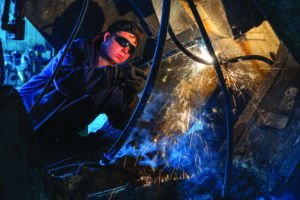
A technician begins the shield rebuilding process. (Photo: Swanson Industries)
With ever increasing panel sizes, it takes a team effort to make sure the longwall reaches the finish line reliably
By Steve Fiscor, Editor-in-Chief
When coal operators move the longwall mining equipment from the stop line of one panel to the start line of the next panel, the clock begins to tick. Production is down and it’s all hands on deck until longwall production resumes. It is a concerted effort to safely move a lot of heavy equipment a few miles underground in a week or less.
The longwall move is also an opportune time to swap out rebuilt equipment and operators take full advantage of that. Almost all longwall operators have spare sets of equipment that allow them to rebuild one set while the other set is mining the current panel, a process referred to as leap-frogging equipment. This allows them to focus on moving the powered roof supports (shields) during the move, which is a major undertaking in itself.
On average, longwall panels have grown consistently in length and width over the last 10 years, which places a greater demand on equipment performance. Cutting corners is a foolish gamble. No one wants to see the ranging arm on a shearer or one of the legs on a shield fail during the first few cuts of a new panel.
There is a lot of pressure to get that longwall moved as quickly as possible. Moving the old equipment out of the mine and bringing the new equipment underground adds another variable to the mix. It’s imperative that the refurbished equipment is ready to go when the next panel begins.
Rebuilding Shields
Swanson Industries and its subsidiaries specialize in rebuilding powered roof supports (shields) for longwall mining. The company takes a lot of pride in the service they provide (See Maintenance, p. 14). With a full rebuild, everything on the shield is evaluated and for those components requiring it, it is either repaired or replaced, so the face operates as good as new when it returns to the mine. “Swanson has the ability to repair, re-chrome and build new cylinders,” said Steve Sangalli, CEO, Swanson Industries. “For longwall legs, we have a preferred relationship with a U.S.-based seal manufacturer, and we have custom design seals that have been qualified underground.”
“We are a one stop shop,” said Jason Sleeth, operations manager at Swanson’s Mt. Morris facility. “We actually have shops across the U.S. where shields are serviced and built. With the recent acquisition of 60% of Tiefenbach North America, we now have inside access to hosing, valving and electric controls. So, customers can drop in and see how the rebuilds are progressing. On top of that, we have a strong service team for future customer support.”
Sleeth managed longwall operations for 20 years before making the leap to Swanson. He admitted that he was a customer before he hired on with them. “I always liked the way that Swanson handled business,” Sleeth said. “Working for Swanson allows me the opportunity to stay involved in an aspect of the coal industry I really enjoy without enduring the rigors of shift work. Plus, I can now benefit Swanson by bringing the customer’s perspective to the project.”
He recalls his days as a customer. “The service aspect was a big selling point for me,” Sleeth said. “When making any major purchase, we would always wonder: Who is going to support this product? Who can support me when the longwall is down?”
Dennis Gibson, operations manager for Swanson’s Helper, Utah location, brings similar expertise to customers in the west. Gibson has nearly 30 years of mining experience and leadership. “Utah and Mt. Morris are a great complement to each other because we provide the same service and support to our customers across the country,” Gibson said.
While the company has a highly respected level of expertise with rebuilding shields and high-pressure hydraulic systems, the company has also partnered with other companies that bring even more expertise to the table, such as, Pete Singleton Systems (PSS), and Tiefenbach Control Systems. With these partnerships Swanson can now provide a holistic shield package all under one roof.
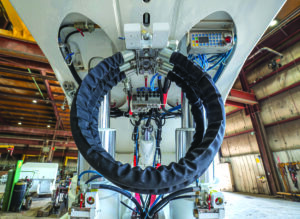
The final product is a fully refurbished shield. (Photo: Swanson Industries)
“Pete Singleton is a trusted entity in the U.S. longwall market,” Sangalli said. “Along with the Swanson team he provides evaluations, repairs, and new shield design and sourcing. During a rebuild, our standard process is to tear the shields down and perform an evaluation. We leverage Pete’s knowledge as our third-party evaluator.”
When the OEMs announced they would no longer manufacture shields in-house, an opportunity to build new shields presented itself to Swanson, and it seemed only natural to partner with PSS in that endeavor as well, Sangalli explained. “And, it’s been a successful decision,” he said. “We have new shields in two different mines today, and we have opportunities to place our third face in another U.S. coal operation soon.”
That’s Swanson’s message to customers: We are here for you. “We are continuing to build our service program and we have some seasoned veterans that are working for us, and we are looking to grow,” Sangalli said.
Maintenance decisions are site specific. Some mines value routine maintenance, service and support and others run the equipment until beyond its economic life and they buy new equipment. “Some of our competitors do not value local service and support. They just want to sell new equipment,” Sangalli said. “That works for some customers, but others prefer a local group servicing both their new and repaired equipment. We are 100% here at our customers sites.”
Most of the shops servicing coal mining equipment are busy these days and repair schedules have long lead times. “We really try to emphasize communication early and often,” Sleeth said. “When will this equipment be coming out for service? What are they wanting? We’re already scheduling business 12 to 18 months out. We need to budget and look ahead to understand workflows.”
“Our shop is mostly full,” Sleeth said. “By the end of the year, we will have repaired 450 shields in 2023. With our expanding capacity, we are looking at close to 700 for 2024. The coal business is cyclic and longwall operators are getting a good price for coal these days. So, they are investing in equipment rebuilds.”
Sleeth estimates four months to rebuild 50 shields. If the mine wants to rebuild a full face of shields (200 or more), they are looking at about a year. If the mine wants to purchase a full set of newly designed shields, the timeframe would be more like 18 months because of the planning and all the required infrastructure.
Swanson offers a customized type of service dependent on the needs of the customers. This can range between a full rebuild and a basic service, which they refer to internally as a wash-and-wax, where they perform an inspection and replace the hoses, and make sure the customer is comfortable with the state of the shields with minimal investment.
In one of their more ambitious rebuilds, Swanson completely overhauled a full face (230 shields) including the switching of controls. The whole process took 18 months.
When it comes to staffing, Sleeth said Swanson is having the same hiring challenges as its peers. “An advantage Swanson brings is that we have a dedicated core group of craftsmen that have been with the company for decades, and they are always willing to train new hires,” Sleeth said. “Our employment levels are 33% higher than 2022 and the average age has also significantly declined.”
“We also have a third group of people who, like Jason, worked in underground coal mining operations,” Sangalli said. “We’re not importing people from other industries or locations. We’re in West Virginia hiring for the mines in West Virginia. We’re in Utah hiring for the mines out West. This goes for anywhere that Swanson operates. We also realize that we must be sensitive to our customers when potentially hiring people from our local communities.”
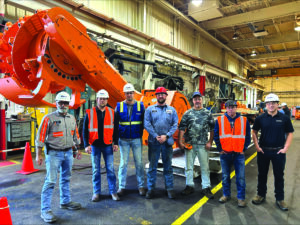
The final inspection for American Consolidated Natural Resources’ (ACNR) shearer rebuild for the Ohio County mine takes place at Komatsu’s Homer City, Pa., facility. Left to right: Jeff Carlton (ACNR), Benji Childers (Komatsu), Gordon Washinsky (ACNR), Jon Rudyk (Komatsu), Brian Wasser (Komatsu), Kenny Bennington (Komatsu), and Kyle Uptegraph (Komatsu).
The mine plan usually dictates the time between rebuilds. At the end of each panel, the mine decides whether to rebuild the shields, how many need service and the level of service (basic or full rebuild). “It’s a balancing act and I sat in that chair for a long time,” Sleeth said. “Mines have budgets and a finite amount of money to spend, and that’s the difference between a wash-and-wax for 30 shields or a full rebuild for 10 shields.”
The risk with the wash-and-wax, however, is that the customer could have an untouched component failure after the first cut of a new panel. The best option, if the funds are available, Sleeth said, is to invest on a full repair, which includes everything, cylinders, hydraulics, hosing, etc.”
Miners that invest in a full rebuild from Swanson can expect those shields to last as long as a new set. The industry standard is 60,000 cycles, Sleeth explained. “On average, a panel equates to 3,500 to 3,800 cycles, depending on the width and length, and most mines pull a panel and a half in a year,” Sleeth said. “My recipe was 3,300 cycles for an 11,000-ft panel.”
Sleeth said he is extremely excited about the direction that Swanson is heading. “We have a great group of people, who are all on the same page, striving for excellence.
“We do see an opportunity to continue to grow,” Sangalli said. “We’re listening to our customers. We’re optimizing where we can. And, we have hired some key people over the last couple of years that will help get us where we need to go in support of our industry.”
Extending Shearer Life
Komatsu is a full longwall system supplier including shearers and armored face conveyors (AFCs), as well as engineered solutions for powered-roof supports (PRS) manufactured through partnerships. All products are supported by facilities scattered across the globe. The company’s facility in Homer City, Pennsylvania, rebuilds all the shearers for all the mines based in northern and central Appalachia, the Illinois Basin and Alabama. Komatsu also has a facility in Wellington, Utah, that rebuilds the shearers operating in the West. Annually, the Homer City facility rebuilds 30 longwall shearers.
“We offer full and partial rebuilds, but normally our customers opt for the full rebuild,” said Shawn Franklin, product manager-longwall shearers for Komatsu Mining. “With the full rebuild, we steam clean the machine, disassemble everything and inspect it. If needed, we use a CMM [coordinate measuring machine] to determine if any items, such as gearcase bores, require welding and re-machining. We basically bring that machine back to OE specifications. Most longwall operators want to go the extra mile to make sure that machine will operate reliably throughout the next panel.”
Longwall panels have grown consistently in length and width over the last 10 years. Longer panels allow longwall operators to mine more coal between moves, which places a greater demand for extended shearer performance. The average panel in the U.S. today is probably 6 to 7 million tons and eight to 10 years ago it was probably 4 or 5 million tons.
“One of the largest panels is 18 million tons,” Franklin said. “That’s pretty dramatic when it comes to getting that shearer across the finish line reliably. Maintenance is important and it definitely played a big part in our shearer being able to successfully mine an 18-million-ton panel. It’s staggering to think that machine went through the entire panel without any major failures whatsoever.
As an OE provider, Franklin realizes that Komatsu needs to meet those ever-increasing expectations. “We work closely with the mines to make improvements and upgrades during the rebuild to maintain world-class availability throughout the entire panel,” Franklin said. “They are raising the bar and we are supporting them. We are up to the challenge.”
Franklin explained one aspect of how Komatsu was able to meet that 18-million-ton challenge. “The ranging arms work really hard on those machines, and it’s always a concern to get those to run an entire panel. The previous record was 12 million tons,” Franklin said. “In this particular case, we worked with the mine to trial a new gear material on the output sun gear in the planetary. It was the weak point in this gear train. The mine agreed to trial the new material and both arms ran the entire panel.”
During the rebuild, Franklin said the trial gears looked brand new, even after 18 million tons. So, they put them in the opposite ranging arms where it would be loaded on the other side the next time around. “Seriously though, these are the type of things that we do to ensure that we work together to lower the cost per ton,” Franklin said. “That’s what it’s all about.”
Frequent rebuilds, generally at 1-year intervals, also offer an opportunity to look at other improvements, like automation. “We have nine machines running now with the Landmark system in the U.S. and we’ve got two more that are going to be commissioned soon,” Franklin said. “We do that type of work too during a rebuild, adding cameras and other devices. There is a big drive toward increased automation.”
During 2024, Komatsu will roll out its new Faceboss 2.0 Control Platform. “We will be upgrading the control systems on a lot of shearers next year,” Franklin said. “Faceboss 1.0’s processing capability is at its limit. Faceboss 2.0 is a large technology jump, providing much higher processing capability. There are a lot of features our control and automation engineers would like to implement on Faceboss 1.0, but honestly it can’t keep up. We’ve been running Faceboss 1.0 for almost 20 years now. We have been redesigning through obsolescence to extend end of life for quite some time now and we’re just coming to the end of the road. We will continue to support Faceboss 1.0 for a few more years.”
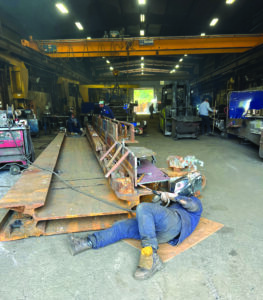
A welder rebuilds an armored face conveyor at Longwall Associate’s shop in Chilhowie, Va.
Building AFCs That Last
Longwall Associates, which is based in Chilhowie, Va., rebuilds AFCs and they make new ones. “We’re very busy these days and it’s still a challenge to keep up with all the work,” said Dennis Heninger, engineering manager for Longwall Associates.
On average, Longwall Associates rebuilds 12 AFCs per year. Next year, they are making the second AFC for the Longview mine and two new AFCs for the expansion at Coronado Global’s Buchanan mine.
“All of mines have a spare AFC, that’s standard operating procedure,” Heninger said. “Some have more than one spare.”
When the AFCs arrive at the shop they are cleaned to a certain extent. If any of the items with a long-lead time need repair, they are removed from the equipment and processed right away. Those items would be gearboxes, motors, couplings, and sprockets. The fabrications are cleaned and assessed to determine the ultimate scope of work. “Some customers want to be a part of that process,” Heninger said. “The majority, however, rely on us to give them our recommendations.”
The couplings are Voith products and they repair and replace them. Longwall Associates sends the motors to Davis Electric. “They are very reliable, and they do a really good job for us,” Heninger said. “The gearboxes and sprockets are repaired in-house at our facility.”
The lead time for rebuilds is still the biggest issue. “That’s a big part of my job and we are continuously planning 12 months ahead of schedule,” Heninger said. “We have a long history with all of our customers, so I generally know ahead of time what will be required.
“Machined components are probably our biggest hurdle,” Heninger said. “We perform specialized machining in-house, and we outsource a fair amount of machining work to local shops.”
The high-alloy steels used for gearing and shafting are still in short supply these days. “It’s critical to get that work started as early as possible to keep projects on schedule,” Heninger said. “We have very specific requirements as far as the specifications for the steel we use and we do not like to deviate from that at all.”
Another aspect that is hard to predict is the mining conditions encountered underground. There are cases where a mine, that may have required a minimal amount of rework and repair in the past, has encountered difficult conditions and the equipment suffers because of it. “For those jobs, we must react quickly,” Heninger said. “More work will likely be needed than in the past and we still need to be able to deliver the equipment as planned.”
Longwall Associates is a little shorthanded these days. As far as the skilled positions, Heninger said that the company has had several people in the shop step up over the past year and a half. “We have promoted them to positions with more responsibility,” Heninger said. “Their skill levels increased and they have taken on more of a leadership role.”
While there is no longer an apprenticeship program, Longwall Associates has hired fresh faces and they are learning from the more experienced people. “Hiring people is not as big of a struggle as it was two or three years ago,” Heninger said. “Smyth County has the Smyth Career Technology Center and Longwall Associates supports them and places people from their program. They have a very good welding program.”
Heninger said the company’s custom approach is one thing that differentiates Longwall Associates from the others. “We’re a custom oriented shop, so we don’t have a standard drive frame or a standard pan,” Heninger said. “Every pan is customized for each individual mine and every piece of equipment.”
Restoring the Electrics
While some longwall mines have their own electrical repair facilities onsite, most of them send their electric distribution centers to manufacturers to be refurbished after each panel. The process varies based on the condition of the equipment. “In some cases, when the units arrive at our facility, the mine operator will indicate they are working fine and they just want us to clean and repaint them, and test the relays and the connections,” said Justin Tidd, chief sales officer, Becker Global – America, Inc. “In most cases, however, they know they have some time before the next panel starts and they opt for upgrades, such as adding programmable logic controllers or other components.”
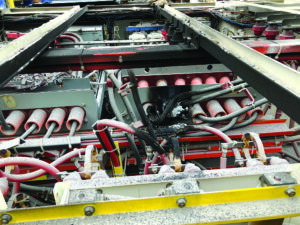
Becker’s Arc Guard System will prevent dangerous, catastrophic failures like this on longwall power supply systems. (Photo: Becker Global – America)
As far as turnaround on an electrical rebuild, Tidd said it depends on the condition of the equipment, but realistically longwall operators can expect 14 to 16 weeks.
Similar to the other major components of a longwall, the operators typically have two sets of electrics. “When they move the panel, they will send that set of electrics out to be repaired and then they will install a refurbished set on the next panel,” Tidd said. “Most of the time, we are rebuilding electric for the panel after the next panel.”
A big trend during the last few years involved replacing GE Multilin relays, which were used widely for longwall controls for their current protection on motor protection, with relays provided by Schweitzer Engineering Laboratories (SEL). “GE was constantly upgrading relays, which made the existing units obsolete,” Tidd said. “The new relays would be a different size and we would need to change the panel configuration. It was frustrating for mine operators.”
Changing a part and modifying a panel is a hassle, but the mines would also need to modify the 2G approval with the Mine Safety and Health Administration (MSHA) with a Revised Approval Modification Program (RAMP). “We are happy to do all of that work for them,” Tidd said. “Our engineers are always working with MSHA, and they would submit the RAMP paperwork required for the new relays.”
In addition to the relays, there has been a large demand on replacing the 4,160V contactor/disconnect assemblies as well. Tidd said, “Traditionally, these output circuits included a 5kv no-load disconnect and a contactor as two products. Becker, has designed and implemented their MVIS slim-line contactor assembly which includes both products into one, but also increases the safety factor for the end user allowing the unit to be open/grounded via motor from a distance.”
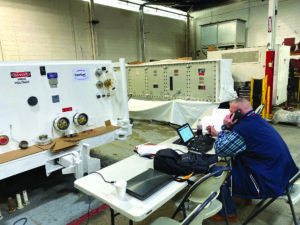
Factory acceptance testing is completed on a set of rebuilt longwall controls. (Photo: Becker Global – America)
Tidd said that one of the things that separates Becker Global from the others is its use of Microsoft Project. “From the time the equipment arrives, our project planner provides a biweekly project schedule so the client always knows where the unit stands in the process,” Tidd said. “I’m fairly certain that we are the only manufacturer in the electrical world that provides this type of service.”
The longwall operator is mining coal from the next panel, Tidd explained. “Meanwhile, they have electrics here, pumps there, and the shearer and the shields somewhere else,” Tidd said. “They meet routinely to determine where each component stands in the rebuild process and if they are on schedule. For us, Microsoft Project helps answer those questions clearly.”
Every two weeks, Becker Global publishes a project schedule, which includes a Gantt chart. It provides percentages toward completion, project timelines and updates on every task. “The client actually sees how the electrical rebuild is progressing throughout the process,” Tidd said.
As far as procuring parts nowadays, Tidd said fuses are hard to find and capacitors are almost impossible to locate, and there are long lead times for almost everything else. “Becker Global manufactures about 70% of the components required for the electrical rebuild on a longwall, which includes low- and medium-voltage connectors, ground monitors, ground fault relays, capacitor trip devices, the vacuum circuit breakers and the transformers,” Tidd said. “So, we have good control over quality and time. We are still buying electrical cables and wire, and circuit breakers, but we control the inventory.”
Becker Global offers an in-house training program. “We have our own small university-style training program,” Tidd said. “Once we find good people, we want to make sure they are trained properly. We invest in education to retain them and we have a strong retention rate.”
Century Mining is getting ready to install the longwall at the Longview mine and that longwall will use Becker Global’s Arc Guard System. “It will be the first arc-resistant longwall power center,” Tidd said. “It’s the safest longwall electrical system that’s ever been made and everyone is excited about it.”




